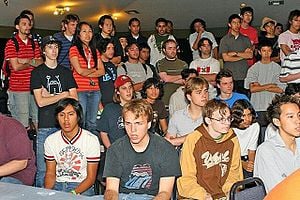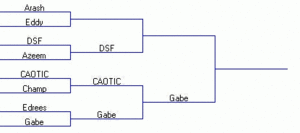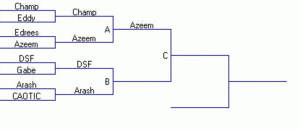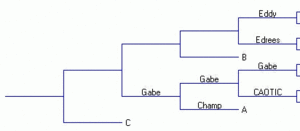Tournament
A tournament is a competition involving a group of players designed to produce an overall skill ranking of the involved players, typically by arranging them into a structured bracket where players engage in individual matches to raise or lower their ranking. Super Smash Bros. Melee has a strong tournament scene dating back to Matt Deezie's Tournament Go series in April 2002, and it and Super Smash Bros. Brawl continue to have strong tournament scenes to this day as well. The online community for the original Super Smash Bros. was not as large during its popular days and thus did not give rise to a significant tournament scene, though competitive SSB64 play does take place over the Internet through services like Kaillera.
Tournaments are considered the premier proving grounds for Smash players. The competitive Smash community tends to look down on players who claim great ability but do not attend well-known tournaments; this is seen by some as an elitist attitude. However, there is a correlation between tournament experience and overall skill.
Locations and sizes
Tournaments are held regularly all over the world, with large communities centering in the United States and Canada; north and western Europe, including The Netherlands, Sweden, France, Australia and Japan. Smaller communities exist in Latin and South America and the Pacific Rim. Major areas of tournament activity in the United States are centered around Southern California, the Maryland/Virginia area, New York, and Indiana, though most states enjoy an active tournament calendar year round.
Various terms exist for describing the size, frequency, and intent of a tournament. They include:
- Smashfest: A smaller event, often without an entry fee, and more friendly than competitive in nature.
- Weekly/Biweekly/Triweekly/Monthly: Repeating tournaments, usually in the same venue. Usually feature the same group of players each iteration.
- STD: "Smash 'Til Dawn", An overnight tournament or smashfest where the goal is to keep playing until the sun rises (or later).
- Circuit Event: Part of a regional circuit of tournaments, such as the Midwest Circuit. Winners are usually given points based on their placings, and an overall points winner at the end of the season is given some sort of prize.
- Regional Tournament: A large tournament that draws significant attendance from neighboring regions. Only top professional players can usually expect to win a regional tournament.
- National Tournament: A larger tournament that draws an extraordinary amount of attendance from around the country, and usually draws some international attendance from foreign countries as well.
Monetary issues
Most tournaments require an entry fee from participants to play. These prices vary by region and tournament size, and differ for each type of event being entered: most bi-weekly events in Southern California charge $5 for singles and $10 total for a team, while similarly-sized east coast United States tournaments usually charge a higher amount. Entry fees go into a "pot" for an event and are awarded to the winners of that event in pre-announced amounts, usually a percentage of the pot (common payout amounts are 60% for first, 30% for second, 10% for third). Tournament directors will usually charge an extra amount, commonly referred to as a venue fee (or take money out of the pot), to help pay for any additional costs to use the venue. Venue fees usually cost about five to ten dollars, though nationals can have venue fees up to $50, especially if the tournament runs over multiple days.
Some schools and other public venues consider gaming tournaments a form of gambling and ban it as such. All tournament directors are encouraged to check with potential venues to make sure they are tolerant of players paying to enter. Several well-known tournaments have had to cancel events when a public official discovered that money was changing hands between players at the event.
Tournament formats
There are four bracket formats used by modern Smash tournaments:
Single elimination bracket
In a single elimination bracket, players are arranged into an hierarchical structure where matches are played between two entrants; the winner advances to play another player the next round and the loser is eliminated from the tournament. The player who wins the very last match of the bracket, after all other entrants have been eliminated, is the winner of the event, and the person who loses the final match finishes in second place. Most sports tournaments (like the NCAA Men's Division I Basketball Championship) use a single elimination format.
Single elimination brackets are often described in terms of the number of entrants playing in the bracket. Because half the remaining players are eliminated during each round of the bracket, the total number of rounds is based on the base-2 logarithm of the entrant count (rounded upwards). 8 players create a 3-round bracket; four rounds for 9 to 16 players; five rounds for 17-32 players; and so on. A bracket's size is usually defined as the smallest power of two that is greater than or equal to the number of entrants. Thus, a bracket with 47 entrants is referred to as a 64 man bracket, because 64 is the smallest power of two which is greater than 47. The size of the bracket also reflects the total number of matches throughout the entire bracket: for an n-size bracket, n-1 matches must be played in total.
Byes are used to fill positions in the bracket when the number of entrants is not a power of two. Any player facing a bye automatically advances to the next round.
Single elimination brackets are rarely used at Smash tournaments for multiple reasons. One such reason players dislike single elimination is that half the players are eliminated having only played a single match (and every player overall gets to play significantly fewer matches). Another reason is that just having one bad match or encountering one bad matchup can result in a premature elimination for a player that would have placed better otherwise, thus giving less room for error, and overall less accuracy in the results. Single elimination also offers much less difference in placing, making them less useful for ranking players' performance.
Tournaments sometimes use them for side events like crew battles to save time, but rarely ever for the primary singles or doubles event. Despite single elimination's flaws, Japanese Smash 64 tournaments often use the single elimination format, even in large, national tournaments.
Double elimination bracket
The double elimination format is by far the most common bracket type at tournaments. A double elimination bracket is derived from the single elimination format but is split into two sections, the winners' and losers' brackets (W and L for short). The W bracket is almost identical to a single elimination bracket; however, losing in the W bracket does not eliminate a player from the tournament. They instead drop into the L bracket at a position that reflects how far they advanced into the W bracket. Anyone who loses in the L bracket (their second loss of the event) is eliminated.
The first round of the L bracket pairs two players who just lost in the first round of the W bracket. The winner of this set then plays a player who drops from the second round of W bracket due to a loss there; the player is placed in the bracket at the letter/number corresponding to the set in W bracket where they lost. (In the images at right, Champ lost at W-A and dropped into L-A.) Further L bracket rounds alternate between these two set setups: two players who survived earlier L bracket rounds play, and the winner of that faces someone dropping from W bracket.
There are three sets in a double-elimination bracket that are of special importance to participants:
- Winners' Bracket Finals: occurs between two players who advance to the last set in W bracket without losing. The winner of this set is guaranteed at least a second place finish, while the loser will at worst finish third. The set in W bracket marked "C" is the winners finals set in the first image at right.
- Losers' Bracket Finals: the loser of the winners' bracket finals plays against the one player to advance through all the L bracket rounds. The loser of this set is awarded third place overall. The set labeled "C" in the second image at right is the losers' bracket finals.
- Championship Set (aka Grand Finals): the end-all set of the event. The winner of this set gets first place, the loser second. The wrinkle in this is that the player from the losers' bracket must win two consecutive sets to win the championship as opposed to the winners' bracket player only requiring one - this is due to the "players are eliminated upon losing two sets" philosophy and has the side effect of discouraging players from intentionally dropping a tough set to fall into the presumed-easier losers' bracket.
These three sets usually require a greater number of individual games to be played before determining a winner. Standard tournament rules have most sets being a set of "best two of three", while the three sets above are often sets of "best three of five."
Every player is guaranteed at least two sets in a double elimination bracket, making it a popular alternative to the single elimination format. The format also affords a player the chance to make a comeback after losing once in W bracket, as well as provide a greater difference in placing, to aid with ranking players' tournament performance.
The size of a double elimination bracket is determined in the same fashion as a single elimination bracket. Half the remaining players are eliminated every two rounds of the L bracket. The total number of sets for an n-size bracket is equal to 2(n-1); thus, a double elimination bracket takes exactly twice as long to complete as a single elimination bracket (assuming the bracket is not reset).
Round robin
Round Robin is a tournament format where every player in the tournament plays every single other player. There are no brackets, no eliminations, everyone just keeps playing until every matchup has been played.
Advantages
- They are perfectly fair, as every player plays the same people, thus preventing players from having an easier/more difficult tournament progression than other players (which is highly probable in a bracket type tournament, due to issues such as faulty seeding or being placed against players who play characters that counter theirs).
- Seeding does not matter, and as such, TOs do not have to spend time creating a bracket while making sure it's seeded properly and balanced, thus allowing the tournament to start sooner.
- They are optimally accurate, as it gives the maximum amount of information from which to base placings off of.
- They provide the most amount of games played, spread equally amongst all players.
- Relating to the point above, they are especially useful in creating more matches and a longer tournament in the event of small turnout, thus allowing small tournaments to feel larger.
Disadvantages
- Round Robins take an infeasible amount of time to complete for more than a dozen or so players. The number of games that must be played increases geometric as more players are added, meaning that Round Robins can only be actually used for small gatherings. For x players, the number of matches required = x(x+1) / 2. To illustrate this problem, if a 256 man Round Robin was done, it would take approximately 6 days of consecutive round-the-clock smashing.
- One rare but potential danger to Round Robin tournaments is the possibility of a tie. Round Robins are not assured to have a clearly cut winner like brackets do. For Example: Say there are 3 players, A, B, and C. A beats B, B beats C, and C beats A. Then A, B, and C all beat everyone else in the tournament. A, B, and C are each in a three-way tie for first place. This principle is not limited to 3 players, though. It is completely possible that everyone in the entire tournament ties for first and last simultaneously.
- Bracket manipulation is much more probable in a Round Robin, as it's significantly more feasible for a higher level player to afford intentionally losing a match or two to friends to boost their placing, while not harming his/her own placing.
- "Meaningless matches" can occur when players are knocked out of contention for advancing to the next round of pools/bracket, and do not care about their overall placing at the end of the tournament. All remaining matches of theirs become "meaningless", as win or lose, the match outcome will have no impact on their capability to secure a spot in the bracket or another round of pools. As a result, these players have no motivation to win any of their remaining matches, and will either drop out (thus automatically forfeiting all remaining matches), or play their remaining matches with half-hearted effort (thus lose matches they would win otherwise). This in turn, undermines the advantages a round robin brings.
Pools
Pools contain a subset of an entrant field, also informally known as "groups". Using this mechanism, players are split into appropiately-sized pools and do a "mini-tournament" with other participants in their pool using the pre-announced pool format, with the most common format being round-robin to yield perfectly accurate results and to give less experienced players more tournament matches. After all matches have finished, players are either seeded or eliminated in their pool based on their performance. Pools are usually used to narrow a large entrant field into a smaller subset for double elimination bracket play or for another round of pools, though they are occasionally just used to seed players in bracket without elimination. Examples of this method are:
- In a tournament with 160 participants, the Tournament Organizer might arrange it so that there are 32 pools of 5 players, and then the top 2 players of each pool would make the 64-man bracket.
- In a tournament with 48 participants, the Tournament Organizer might arrange it so that there are 8 pools of 6 players, and then the top 4 players of each pool would make the 32-man bracket.
- In a tournament with 224 participants, the Tournament Organizer might arrange it so that there are 32 pools of 7 players, and then the top 2 players of each pool would make the 64-man bracket.
In sufficiently large tournaments, 2 or more rounds of pools would be adequate to useful. Examples are:
- Apex 2012 Brawl singles - 400 participants
- 80 pools of 5, top 2 players of each pool advanced to a second round of pools, yielding 160 participants.
- 32 pools of 5, top 2 players of each pool advanced to the 64-man bracket.
- Zero Challenge 2 - 192 participants
- 32 pools of 6, top 3 players of each pool advanced to a second round of pools, yielding 96 participants.
- 16 pools of 6, top 4 players of each pool advanced to the 64-man bracket.
Pools are usually only employed at large tournaments. N number of entrants are split into P number of pools, and the top Y finishers in each pool are either placed into a second round of pools or seeded into a double elimination bracket, which proceeds normally. The number of entrants for the subsequent round or bracket is P*Y. Placing well in a pool gives a player a better position in a bracket or the next round of pools, giving extra incentive to strive for the top pool positions. Tournaments using pools will result in a significantly larger amount of games being played than without them. There is a total of B(B-1)/2 sets per pool, with B players per pool. Thus a round of round-robin pools with N participants total requires a grand total of N(B-1)/2 sets.
Swiss system
The Swiss System, as used heavily in the professional chess world which guarantees each player the same number of matches and attempts to match players against others of similar skill throughout the tournament. Swiss system tournaments are rare in the Smash community due to their complexity and the large number of matches they create.
Players are assigned matches in the first round either randomly or based on some method of seeding (an attempt to rank players in order of skill before the tournament starts). Winning this set gives a player 1 "point", and losing does not give any points. Each successive round involves pairing two players with the same number of points (attempting to avoid repeat matchups), playing out those matches, assigning points, and repeating for the next round. Swiss systems generally run until only a single person has no losses; this will occur after R rounds, where R is the base-2 logarithm of the total number of entrants, rounded upwards. Swiss brackets are sometimes run for a pre-determined number of rounds, with the winner being the person with the most points overall.
Modified Swiss system
While the Swiss System is rare in the Smash community, a modified version is in use in at SLAPAHO tournaments in Iowa City. In these tournaments, 3-5 rounds of preliminary swiss systems rounds are run. They are best of three, with a a 2-0 victory earning 4 points, and 2-1 victory earning 3 points, a 1-2 loss earning 1 point, and a 0-2 loss earning 0 points. After a set number of preliminary rounds, the top eight players are seeded according to points and a normal double or single elimination tournament commences.
Side events
Side events are events played on the side of the primary singles/doubles tournament. They are usually done for "fun", as well as to play under conditions that couldn't be done as its own standalone event, and to potentially attract players who wouldn't attend for just the primary singles/doubles tournament. Side events, being less serious in nature, usually have a lower entry fee to enter. Common examples of side events include:
Low and mid tier tournaments
A low tier tournament is a tournament that runs under standard rules, with the stipulation being players can only play low and bottom tier characters. What tiers are considered "low tier" is at TO discretion. The main purpose of a low tier tournament is to play as characters under tournament conditions that would otherwise be rare in standard tournaments, as only a few players, such as Gimpyfish and Mekos, have been able to place at major tournaments with low tier characters.
A mid tier tournament is similar to a low tier tournament, except characters in middle tier can be played, with those in the top and high tiers being banned. What tiers are considered "mid tier" is at TO discretion. The main purpose of mid tier tournaments is to have greater character variety than what a low tier tournament would allow, without having to see the abundance of top and high tier characters that occurs in standard tournaments.
Crew battles
- Main article: Crew battle
Occasionally crew battles are run as an official side event, where they can either be two large crews competing, or an entire tournament of many crews. Crews can either be preexisting crews, players from the same region/close regions being grouped into a crew, and/or draft crews, where a team captain drafts other participating players at the tournament to comprise their crew.
Brawl mod tournaments
A common side event is a tournament played with one of the various game mods of Brawl, primarily done to see how the mod plays under tournament conditions. Project M and Brawl Minus are the most commonly played Brawl mods, with Brawl Plus fading into obscurity as it lost its initial support while other mods came into existence, and Balanced Brawl never enjoying a run as an often played Brawl mod.
All Brawl
All Brawl is a more casual side event, where players compete in four-player free-for-alls, with items on and every stage legal. The ruleset used for Apex 2012's All Brawl event was:
- Bracket is single elimination.
- 4 players per set.
- All stages on with stage choice set to random.
- All characters are set to random.
- Top 2 players advance.
- All items are on and set to medium.
- First player to win 2 games advances.
- 2nd person to advance is decided in the order of: games won, stock left in the last game, most KOs in the last game.




